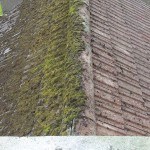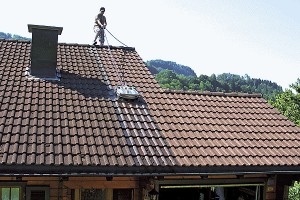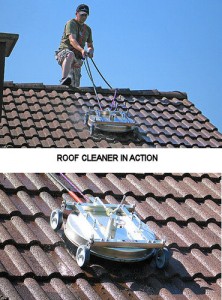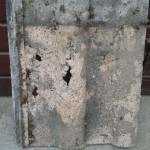So what is the best option for roof moss removal?

There are a few methods available for roof moss removal
- High pressure cleaning
- Biocide treatments
- Manual scrape & brush removal
- Copper plating (Copper)
There are good and bad points for each of these roof moss removal options, and different methods can be used, and are recommended, for some types of roofs and not for others, so it’s not a straight forward do this or do that answer unfortunately.
So here is some additional info for each option to help you make your mind up (and if you are still unsure after reading this, remember that quotes and advice are free, and no salesmen will call to try and badger you into something that you didn’t really want)
- Pressure – high pressure cleaning is best suited for roofs where a roof coating application is desired (never have you roof coated without a pressure clean first, roof coatings don’t stick well to dirt!), as it provides the most effective and thorough cleaning possible. A word of warning though, make sure the company you choose to do this will use a rotary cleaner and not traditional hand held lances, as blasting away with a high pressure lance, w
hile stomping about all over your roof, it is not recommended and can do more damage than good. - Biowash – Biocide treatments are available in various forms, from traditional Ddac type solutions to the newer (and more environmentally friendly) biogrowth removers. The modern bio products are our preferred option and are very effective when used properly. Regarded as being highly biodegradable and plant friendly. The roof should be scraped and brushed clear of surface growths before application (bio works on the roots and spores which it can’t always get to when there is heavy growth present) and should ideally be applied in dry weather to give it a chance to work properly
- Softwash – Softwashing is an american technique where a strong solution of bleach, detergent and surfactants is sprayed on to the roof surface providing a quick cleaning effect and at the same time killing organic growths. This can be applied as a one off spray on and leave to weather clean, or as a spray and wash off technique, if using the wash off option it is generally recommended to followup with a biowash in order to provide a level of ongoing protection to the tile surface
- Manual scrape/brush – Manual scraping on its own for roof moss removal is a poor option, as it does not remove the roots and spores which can cause quick regrowth of the problem. However if done alongside a Biocide or Softwash treatment it is a better option than pressure cleaning for long term roof moss removal
- Copper plating – Don’t bother! It just doesn’t work well, we’ve cleaned many roofs that have had copper plates/wires fixed to them and in a few cases even had moss growing on the copper itself (details & pics available on request)
So to sum up:
- Rotary pressure clean = any roof preferably before a coating is applied
- Scrape & Biocide/Softwash = any roof that requires moss removal without a sealer or coating
- Softwash – Roofs with a low level of moss growth and where badly discoloured
- Scrape & brush = on it’s own is not long lasting, and has no cleaning effect on the tiles
- Pressure washing = not generally recommended for roofs unless followed by a coating, and only when done by a rotary cleaner

So there you have it, a basic guide to roof moss removal, but if you would like to know more, to discuss further or have a quote prepared for your own roof, please call and ask.
Roof cleaning FAQ

So why is a rotary cleaner better than a man with a lance?
Because the operator is able to stay at the roof ridge while the cleaning is done, this reduces the possibility of damage to your tiles, and increases safety for the workers.The cleaning head is simply allowed to roll down the roof, washing the moss off as it goes.
Scrape and biocide?
Where the roof tile is old and where the original coating has worn out, pressure cleaning will return the tile to it’s original concrete colour, and while it will be clean enough, it generally doesn’t look great and would really require a coating to provide protection afterwards, so manually scraping the growths and applying an effective biocide treatment can be a good option where a coating or sealer application is not desirable
How much does it all cost?
Moss removal and roof cleaning is more expensive than general pressure washing, no doubt about it, safety equipment and extra precautions are needed, more pre-wash preparation is required, and more time to clean up afterwards, gutters and down pipes will need cleaned and wash out afterwards, and sometimes scaffolding will be required.
But it’s not all bad news, as with prices starting at £450 for moss removal and roof cleaning (small terraced or semi-detached property) it may not cost as much as you think (and certainly less than some roof cleaning companies would have you believe!).
Roof Moss removal…is it really necessary?
The most common response we get when we suggest it is best to use a moss removal service to clean a dirty or moss covered roof is…
“Roof moss/algae is only cosmetic and doesn’t do any harm”
Fact or fiction?
A bit of both is the reality here, as while the initial and early growth is really only a cosmetic issue, if left alone and allowed to continue, roof moss has the ability to shave years off the life of your roof, it can grow under, and cause slates to lift, and then allow rain water in, it act’s like a sponge and soaks up water, adding weight and dampness to your roof area (20-30 times it’s own weight in water) and provides a home for an amazing amount of insects which then attract birds which leave their own mess behind (!), so moss removal should be regarded as highly beneficial at the least.
And long term the growths can damage the surface, by the effect of both the roots that grow

into it and by the water they hold against the surface, normally expected to simply run off, but is now held there keeping the roof constantly damp and subject to damaging freeze thaw cycles.
So moss removal, and preferably foloowed by a protective coating (for additional long term protection), makes a whole lot of sense, or it could mean a replacement roof or extensive repair work may well be the eventual result of your inaction.
And with the cost of a new roof being many thousand of ££££’s having a moss removal service carried out, or a clean and coat, is a much more cost effective option.
